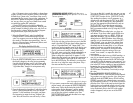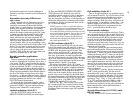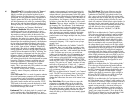"live" after you exit the FUNCTION mode by pressing
one of the [MEMORY SELECT] buttons (internal or
cartridge). The [DATA ENTRY] controls only change
the last used parameter prior to pressing the [MEM-
ORY SELECT] button. This feature can be useful as an
additional live performance control. For example, you
might go into the EDIT mode and select [LFO
SPEED]. Then go back to the PLAY mode and you can
play any voice you like and change its LFO speed by
moving the [DATA ENTRY] controls. Similarly, you can
go into FUNCTION mode and adjust [MASTER
TUNE], then go back into PLAY mode and use [DATA
ENTRY] to tune a voice. One application of this charac-
teristic is to achieve simulated "doppler shift" with the
train bell or whisltle (Doppler effect is the increase in
pitch that occurs as two objects move closer togther at a
rapid rate, and the decrease in pitch as they move
apart).
One of the most important parameters to access dur-
ing performance is the POLY/MONO mode selection.
You can exit FUNCTION mode after first pressing
[POLY/MONO], and then toggle between these modes
while playing various voices.
The ability to change the last selected FUNCTION
parameter is particularly useful for changing the
portamento characteristics. For example, you can enter
FUNCTION mode and adjust the [PORTAMENTO
TIME], then play a voice and alter that time as you play.
A very useful "trick" relies upon the difference in por-
tamento that occurs between polyphonic and mono
modes. As explained here, you can use [DATA
ENTRY] to switch between fingered portamento with a
mono keyboard (useful for a Fretless Bass voice), and no
portamento with a polyphonic voice (Electric Piano, for
example).
1. Wire a standard phone jack so its tip is shorted out to
its sleeeve (jumper from tip to sleeve). Insert this plug
in the Portamento Foot Switch jack on the back of the
DX7. It has the same effect as though you plugged in
a foot switch but did not step on it.
2. Enter FUNCTION mode. press [POLY/MONO], and
set the instrument for MONO operation.
3 Press [PORTAMENTO MODE] and select "FIN-
GERED PORTA". You'll notice that fingered porta-
mento is not sensitive to the portamento foot switch,
so it will work even though the shorted jack is
present.
4. Press [POLY/MONO] again before leaving FUNC-
TION mode so that the [DATA ENTRY] slider or
[ON] and [OFF] buttons will toggle the keyboard
between polyphonic and mono operation.
5. Press [MEMORY SELECT] (internal or cartridge) to
enter the PLAY mode.
When you select a voice like the Fretless Bass, push
up [DATA ENTRY] or press [>] to set the DX7 to
MONO mode. You can now use fingered portamento
(holding one key while pressing and releasing
another) to achieve a pitch bending glide to the next
note, or play notes sequentially to avoid portamento.
If you select another voice, such as Electric Piano, pull
down [DATA ENTRY] or press [<] to return to poly-
phonic operation; since the portamento jack is
shorted, there will be no portamento on that voice. If
you want, you can use a foot switch in the Porta-
mento jack, in which case the portamento would be
active in POLY mode when you step on the pedal.
If you don't want to accidentally have a parameter
change whenever you're in PLAY mode, select a non-
critical parameter before you exit the FUNCTION
mode. From FUNCTION mode, for example, you
might press [BATT CHECK] before going into PLAY
mode. This will avoid accidental, unexplained
changes while you are playing.
Reference Sources on FM Synthesis
FM digital synthesis, of the type used in the DX syn-
thesizers, was pioneered by Dr. John M. Chowning and
his associates at Stanford University in the early 1970's.
A number of research papers have been published, and
offer the technically-inclined reader ample opportunity
to understand the theory and mathematics of FM syn-
thesis.
John M. Chowning, "The Synthesis of Complex Audio
Spectra by Means of Frequency Modulation," Journal
of the Audio Engineering Society Vol. 21,
#
7 pp 526-
534 (Sept. 1973); reprinted in Computer Music Jour-
nal, Vol. 1,
#
1, pp 46-54 (April 1977).
John Grey, "An Exploration of Musical Timbre," PhD
Dissertation, Dept. of Psychology Stanford University
(Feb. 1975); distributed through the Dept. Music, Tech.
Rep. Stan-M2.
James A. Moorer, "The Synthesis of Complex Audio
Spectra by Means of Discrete Summation Formulas,"
Journal of the Audio Engineering Society, vol. 24,
#
9,
pp 717-727 (Nov. 1976).
James A. Moorer and John Grey, "Lexicon of Analyzed
Tones (analysis and plotting programs), Part I: A Violin
Tone," Computer Music Journal (Box E, Menlo Park,
CA 94025), 1(1): 39-45 (1977).
Bill Schottstaedt, "The Simulation of Natural Instru-
ment Tones using Frequency Modulation with a Com-
plex Modulating Wave," Computer Music Journal, pp
46-50 (Nov. 1977)
Marc LeBrun, "A Derivation of the Spectrum of FM
with a Complex Modulating Wave," Computer Music
Journal, pp 51-52 (Nov. 1977)
54


















